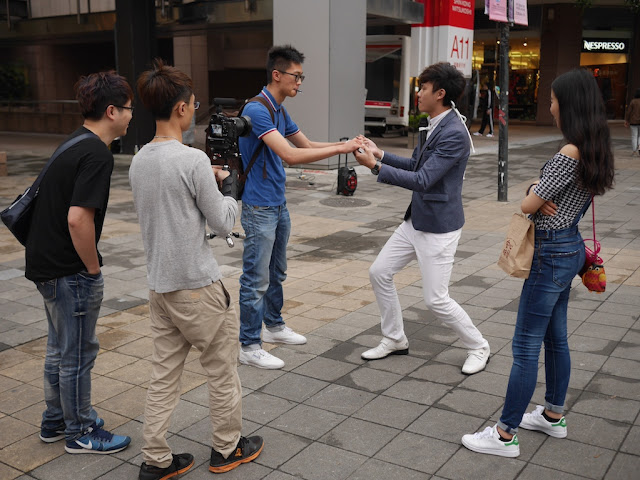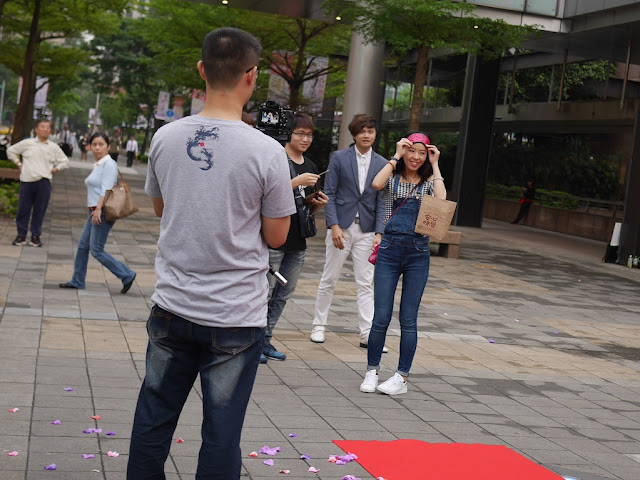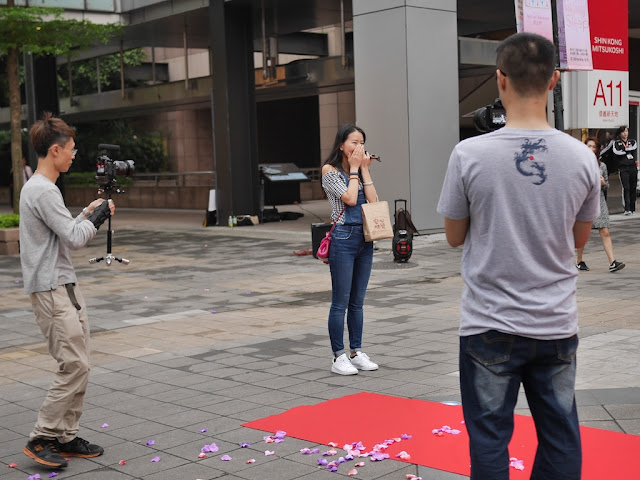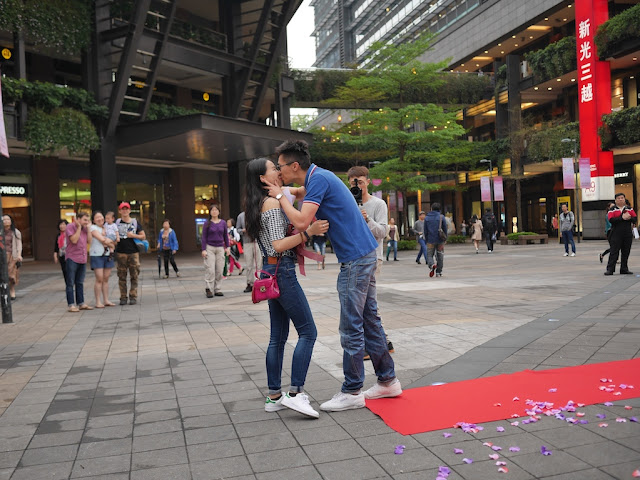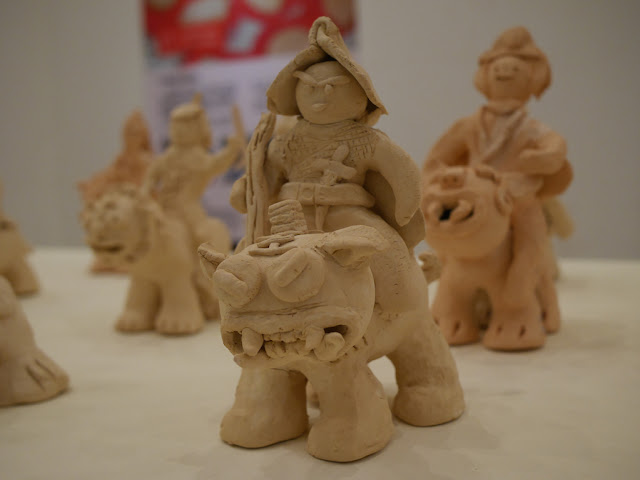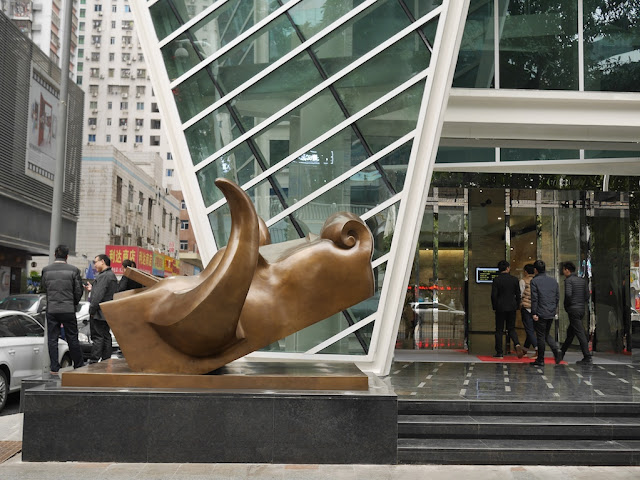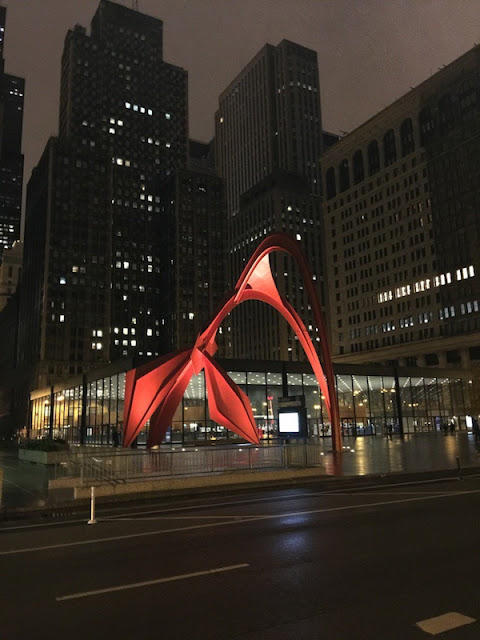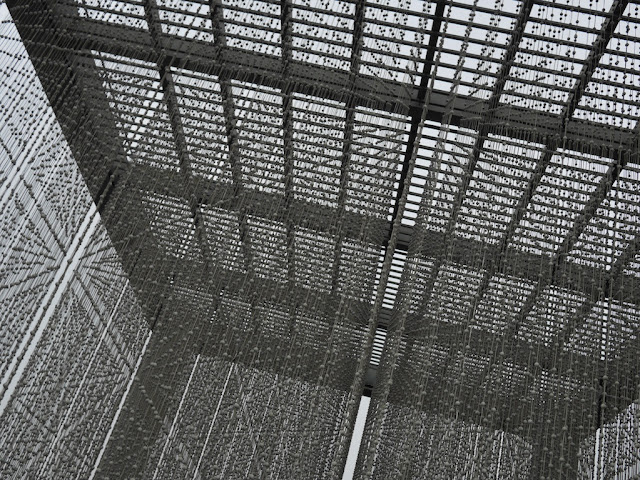Showing posts with label Creativity. Show all posts
Showing posts with label Creativity. Show all posts
Wednesday, June 29, 2016
Thursday, June 16, 2016
Friday, May 27, 2016
Monday, May 23, 2016
Wednesday, April 13, 2016
A Magical Proposal in Taipei
Posted by
Brian Glucroft
at
11:57 PM
Yesterday afternoon while working on a project outside at the Xinyi Shoppping District in Taipei, Taiwan, I saw a magician perform for a young couple.
I had seen the magician in the same plaza earlier when he appeared to be waiting for someone or something. I considered why the magician chose this particular couple and why two people were capturing it all on video. The videographers were at times clearly interested in making sure the female stayed in the scene even when the magician was focused on her partner.
After several magic tricks, the magician covered the young woman's eyes with an eye mask for the next trick. I figured it was time for me to move on. But then I saw a person rolling out a red carpet, and I began to wonder if there was something more taking place than I had at first assumed. Immediately after that I saw somebody holding flowers. Oh . . .
Flower petals were spread on the carpet. If this was just a trick, it was really going over the top.
While these preparations quietly occurred, the magician kept the woman occupied.
With the young man holding a bouquet of roses while briefly biting his lower lip and others holding "Would you marry me" signs behind him, it was clear a bit more than a magic act was about to occur.
Soon all was ready for the reveal, and the young woman was told to take off the mask. At first, she had an ordinary smile.
And then it grew.
But she appeared unsure and began to search for something. Soon, she had what she needed — a pair of glasses.
I don't know what was going through the young woman's mind, but she was reserved in her expressions. She may have been wondering if this could somehow be part of a magic act. But then her boyfriend began a long speech.
If she had any doubts, they melted away.
As I watched, I realized online videos of public marriage proposals gone awry have left their mark on me. No worries here though. What followed went well.
Soon the newly engaged couple walked off to sit on a nearby bench together, and the efficient cleanup began.
They even picked up the flower petals, so Taiwan.
Later, the couple took advantage of having a photographer around and posed for some photos. The young woman looked far more relaxed. For me, this was the moment where I erased any question whether the young woman's "yes" might have only been a polite face-saving public reaction.
Best wishes to the newly engaged couple. Even for me, the luck involved in witnessing their special moment seemed like a bit of magic. Perhaps I should have expected it. About half an hour earlier I had noticed a statue overlooking the same plaza.
The small statue of a mythical god is titled "Cupido".
I had seen the magician in the same plaza earlier when he appeared to be waiting for someone or something. I considered why the magician chose this particular couple and why two people were capturing it all on video. The videographers were at times clearly interested in making sure the female stayed in the scene even when the magician was focused on her partner.
After several magic tricks, the magician covered the young woman's eyes with an eye mask for the next trick. I figured it was time for me to move on. But then I saw a person rolling out a red carpet, and I began to wonder if there was something more taking place than I had at first assumed. Immediately after that I saw somebody holding flowers. Oh . . .
Flower petals were spread on the carpet. If this was just a trick, it was really going over the top.
While these preparations quietly occurred, the magician kept the woman occupied.
With the young man holding a bouquet of roses while briefly biting his lower lip and others holding "Would you marry me" signs behind him, it was clear a bit more than a magic act was about to occur.
Soon all was ready for the reveal, and the young woman was told to take off the mask. At first, she had an ordinary smile.
And then it grew.
But she appeared unsure and began to search for something. Soon, she had what she needed — a pair of glasses.
I don't know what was going through the young woman's mind, but she was reserved in her expressions. She may have been wondering if this could somehow be part of a magic act. But then her boyfriend began a long speech.
If she had any doubts, they melted away.
As I watched, I realized online videos of public marriage proposals gone awry have left their mark on me. No worries here though. What followed went well.
Soon the newly engaged couple walked off to sit on a nearby bench together, and the efficient cleanup began.
They even picked up the flower petals, so Taiwan.
Later, the couple took advantage of having a photographer around and posed for some photos. The young woman looked far more relaxed. For me, this was the moment where I erased any question whether the young woman's "yes" might have only been a polite face-saving public reaction.
Best wishes to the newly engaged couple. Even for me, the luck involved in witnessing their special moment seemed like a bit of magic. Perhaps I should have expected it. About half an hour earlier I had noticed a statue overlooking the same plaza.
The small statue of a mythical god is titled "Cupido".
Thursday, April 7, 2016
Two Mythical Qilins on Display in Kinmen
Posted by
Brian Glucroft
at
12:07 AM
I have been unexpectedly occupied since praising Yeh's Fermented Eggs. So for today, I will keep it simple and share four photos of artistic creations on display at the Historical Folk Museum in Kinmen.
The qilin (麒麟) sculptures made during the time of the Xuande Emperor, who ruled from 1425 to 1435, were two of my favorites at the museum.
Another set of sculptures at the museum, these made recently by children, provided an unexpected variation on the imaginary creature theme.
Perhaps in 600 years they too will be displayed as examples of ancient art.
The qilin (麒麟) sculptures made during the time of the Xuande Emperor, who ruled from 1425 to 1435, were two of my favorites at the museum.
 |
| Sculpture of a qilin ridden by a "golden boy": 七寶銅麒麟 - 金童 |
 |
| Sculpture of a qilin ridden by a fairy: 七寶銅麒麟 - 仙女 |
Another set of sculptures at the museum, these made recently by children, provided an unexpected variation on the imaginary creature theme.
Perhaps in 600 years they too will be displayed as examples of ancient art.
Monday, March 14, 2016
Promoting a New Ceramics Center in Xiamen with a Snowman and a Ghost
Posted by
Brian Glucroft
at
12:34 AM
I previously didn't offer any explanation for a nativity scene in Xiamen which included a snowy Disney character. But, as usual, context matters, so now I will share some.
There were two related displays at the Zhongshan Road Pedestrian Street. Neither had a similar Christian theme.
Long story short, they were all part of a promotion for the grand opening of the Shunmei Ceramic Cultural Center.
According to the Shunmei Group's website, the company has passed a "factory audit of Disney". The website currently features some Frozen-themed items.
Olaf's presence in the nativity scene now seems less mysterious — same with the Snow White and the Seven Dwarves' and even the non-Disney minion's presence in the first photo above.
A Shunmei post in Chinese provides some examples of the items which would be available for purchase at the Shunmei Ceramic Cultural Center. It also has an advertisement for the grand opening which includes part of an iconic scene from the movie Ghost.
This raises obvious questions such as "Where is Olaf?" and "Are they making a ceramic minion?"
This is yet another example where digging deeper raised more questions than it answered. But at least some were answered. Maybe.
There were two related displays at the Zhongshan Road Pedestrian Street. Neither had a similar Christian theme.
Long story short, they were all part of a promotion for the grand opening of the Shunmei Ceramic Cultural Center.
According to the Shunmei Group's website, the company has passed a "factory audit of Disney". The website currently features some Frozen-themed items.
Olaf's presence in the nativity scene now seems less mysterious — same with the Snow White and the Seven Dwarves' and even the non-Disney minion's presence in the first photo above.
A Shunmei post in Chinese provides some examples of the items which would be available for purchase at the Shunmei Ceramic Cultural Center. It also has an advertisement for the grand opening which includes part of an iconic scene from the movie Ghost.
This raises obvious questions such as "Where is Olaf?" and "Are they making a ceramic minion?"
This is yet another example where digging deeper raised more questions than it answered. But at least some were answered. Maybe.
Wednesday, March 9, 2016
Tuesday, January 26, 2016
The Name for an Unusual Building in Shenzhen
Posted by
Brian Glucroft
at
11:59 PM
Yesterday's post included a photo of a building in Shenzhen with an unusual design.
I didn't worry about identifying the building when I took the photo two weeks ago. I expected it would be easy to figure out later online. But the best I could do last night in a short amount of time was find the building on Baidu Map's street view where it is covered by scaffolding. No name appeared for the building, and an image search of the photo proved fruitless.
While at the nearby Dongmen Pedestrian Street area today, I unexpectedly caught a glimpse of the building down an alley. Feeling inspired, I decided to identify it the old fashioned way and made my way to a passageway where I could cross Shennan East Road underground while perusing the items sold by various hawkers. Upon arriving at the building, I considered what appeared to be a bovine-inspired sculpture next to the building's main entrance.
I walked into the main lobby, and a security guard soon approached. Perhaps he was from the nearby Shenzhen Security Service Company.
The seemingly nervous security guard answered a few questions before he stopped to salute an older man walking by. The man had a puzzled expression when he looked at me. Probably to nobody's surprise, we both refrained from any saluting.
After leaving the building, I pondered a nearby Land Rover advertisement with a snow covered scene.
Although Shenzhen has experienced unusually cold weather recently, snowy roads are rarely a worry. It snowed in Guangzhou, not far away to the north, yesterday for the first time in 50 years (added note: parts of Shenzhen reportedly saw snow as well).
Anyway, the building under question holds the Ruihe R & D Center and is creatively named the Ruihe Building (瑞和大厦). According to Reuters:
I didn't worry about identifying the building when I took the photo two weeks ago. I expected it would be easy to figure out later online. But the best I could do last night in a short amount of time was find the building on Baidu Map's street view where it is covered by scaffolding. No name appeared for the building, and an image search of the photo proved fruitless.
While at the nearby Dongmen Pedestrian Street area today, I unexpectedly caught a glimpse of the building down an alley. Feeling inspired, I decided to identify it the old fashioned way and made my way to a passageway where I could cross Shennan East Road underground while perusing the items sold by various hawkers. Upon arriving at the building, I considered what appeared to be a bovine-inspired sculpture next to the building's main entrance.
I walked into the main lobby, and a security guard soon approached. Perhaps he was from the nearby Shenzhen Security Service Company.
The seemingly nervous security guard answered a few questions before he stopped to salute an older man walking by. The man had a puzzled expression when he looked at me. Probably to nobody's surprise, we both refrained from any saluting.
After leaving the building, I pondered a nearby Land Rover advertisement with a snow covered scene.
Although Shenzhen has experienced unusually cold weather recently, snowy roads are rarely a worry. It snowed in Guangzhou, not far away to the north, yesterday for the first time in 50 years (added note: parts of Shenzhen reportedly saw snow as well).
Anyway, the building under question holds the Ruihe R & D Center and is creatively named the Ruihe Building (瑞和大厦). According to Reuters:
SHENZHEN RUIHE CONSTRUCTION DECORATION CO., LTD. is principally engaged in the design and construction of building decoration projects. The Company provides decoration and construction services for shopping malls, hotels, hospitals, curtain, subways, finance, office buildings and theaters, among others. The Company operates its businesses in domestic markets.And now one loose end is tied up.
Monday, December 21, 2015
Two More Shanghai Scenes
Posted by
Brian Glucroft
at
11:40 PM
I was tempted to included two more photos in the previous post "Twenty Shanghai Scenes Not Featuring Luxury Malls or Skyscrapers", but they didn't quite fit the theme which emerged. So I will share them separately here.
One photo captures a portion of a destination especially popular for tourists and shoppers: the Nanjing Road Pedestrian Street.
The other photo includes tall buildings in the background.
In front of the buildings is a collaborative creation (link in Chinese) by Yu Jiyong (余积勇) and Shen Tingting (沈婷婷): the May Thirtieth Movement Monument in People's Park.
The locations where these photos were taken are just minutes away from each other by foot. And I have stories for both. Another day . . .
One photo captures a portion of a destination especially popular for tourists and shoppers: the Nanjing Road Pedestrian Street.
The other photo includes tall buildings in the background.
In front of the buildings is a collaborative creation (link in Chinese) by Yu Jiyong (余积勇) and Shen Tingting (沈婷婷): the May Thirtieth Movement Monument in People's Park.
The locations where these photos were taken are just minutes away from each other by foot. And I have stories for both. Another day . . .
Tuesday, November 17, 2015
Two Mobile Moments on Stringless Sculptures in Changsha
Posted by
Brian Glucroft
at
12:44 PM
Earlier this year at pedestrian street in Changsha I considered "the competing interests between those who wish to use a suitable sculpture for an extended period of time as a place to sit with others who desire to use it more fleetingly for photos". When I stopped by a shopping center during a recent day in Changsha, I saw people using two previously-noticed sculptures with stringless string instruments for the former purpose.
In both cases, not only was someone taking advantage of a place to sit but their attention was focused on a mobile phone – a theme for some future posts about Changsha.
In both cases, not only was someone taking advantage of a place to sit but their attention was focused on a mobile phone – a theme for some future posts about Changsha.
Tuesday, October 27, 2015
Imitated Art: Giant Abstract Flamingos in Chicago and Zhuhai
Posted by
Brian Glucroft
at
11:59 PM
Dali L. Yang, Professor in the Department of Political Science at the University of Chicago, recently tweeted a photo of a sculpture by the American artist Alexander Calder (1898-1976).
The Chicago Public Art Program's description of the "Flamingo" emphasizes how the sculpture fits in with its surrounding environment and offers an immersive experience:
Perhaps too similar. Unfortunately, I haven't been to Chicago in years. Instead, I took the photo in China — more specifically, at the Huafa Mall in Zhuhai, Guangdong.
No Bauhaus-style federal buildings border the mall's plaza, and some differences exist between the Zhuhai sculpture and Calder's. But it is hard to believe the striking resemblance is a coincidence, and the Calder Foundation makes no mention of this work.
There have been times when an example of "China copied!", often a justifiable claim, struck me as being no more a copy than examples in the West which were not similarly called out. Many of the most celebrated artists have used others' ideas and material to one degree or another. The line between imitation and similar-in-style can be fuzzy. Some of Calder's own works made me immediately think of earlier artists. And the more I compared photos of the sculptures in Zhuhai and Chicago the more differences I noticed. Revisiting both in person may uncover more.
Nonetheless, I strongly lean towards calling the Zhuhai sculpture an imitation. At best, it seems to be rather near that fuzzy boundary. It would be interesting to know whether the differences are primarily a result of artistic considerations, a desire to technically avoid the "copy" label, or failing to perfectly copy Calder's sculpture.
Whatever the artistic, ethical, and legal issues, though, there is a positive side to apparent imitations like the one in Zhuhai. For example, relatively few people in Zhuhai will ever have the opportunity to visit Chicago or support its tourism industry. At least they can now better experience something similar to its art, if not its deep-dish pizzas and hot dogs. From this perspective, it could be argued it would be better if the Zhuhai sculpture were an exact copy.
Regardless, clearly crediting the original, which I didn't see in Zhuhai, would improve things — perhaps something to the effect of:
In his thoughts about another Chicago sculpture with a twin in China, Jonathan Jones, who writes on art for the Guardian, had this to say about creativity and Chinese art:
Even if China feels artistic imitations are justifiable, not openly identifying them as such detracts from the work of artists all over the world. And in a special way it hurts Chinese artists who create original work in the 21st century. An environment exists where it is all too easy to think "this might be an imitation".
Nobody is now wondering if Calder copied a sculpture in Zhuhai.
Chicago in a rainy Saturday evening pic.twitter.com/UbGeX5z2G3
— Dali L. Yang (@Dali_Yang) October 25, 2015
The Chicago Public Art Program's description of the "Flamingo" emphasizes how the sculpture fits in with its surrounding environment and offers an immersive experience:
Alexander Calder’s abstract stabile anchors the large rectangular plaza bordered by three Bauhaus style federal buildings designed by Mies van der Rohe. The sculpture’s vivid color and curvilinear form contrast dramatically with the angular steel and glass surroundings. However, Flamingo is constructed from similar materials and shares certain design principles with the architecture, thereby achieving successful integration within the plaza. Despite its monumental proportions, the open design allows the viewer to walk under and through the sculpture, leading one to perceive it in relation to human scale.Seven years ago, David Mendell for the Chicago Tribune shared how the cost for a needed renovation at the time may have been justifiable simply in terms of attracting tourists:
Art lovers and conservationists maintain the expenditures are essential, and economical, if Chicago is to continue drawing tourists who want to view public art.Fortunately, Calder's work didn't disappear. Two months ago, I felt inspired to take a photo similar to Yang's:
"These works really show the commitment Chicago has to promoting (the city's) cultural landscape in the last half of the 20th Century," said Victor Simmons, director of education for the Chicago Architecture Foundation. "It would be a great loss if those two contemporary works were allowed to disappear."
Perhaps too similar. Unfortunately, I haven't been to Chicago in years. Instead, I took the photo in China — more specifically, at the Huafa Mall in Zhuhai, Guangdong.
No Bauhaus-style federal buildings border the mall's plaza, and some differences exist between the Zhuhai sculpture and Calder's. But it is hard to believe the striking resemblance is a coincidence, and the Calder Foundation makes no mention of this work.
 |
| Photo by Min Lee of Calder's "Flamingo" in Chicago taken from a more a easily comparable viewpoint |
There have been times when an example of "China copied!", often a justifiable claim, struck me as being no more a copy than examples in the West which were not similarly called out. Many of the most celebrated artists have used others' ideas and material to one degree or another. The line between imitation and similar-in-style can be fuzzy. Some of Calder's own works made me immediately think of earlier artists. And the more I compared photos of the sculptures in Zhuhai and Chicago the more differences I noticed. Revisiting both in person may uncover more.
Nonetheless, I strongly lean towards calling the Zhuhai sculpture an imitation. At best, it seems to be rather near that fuzzy boundary. It would be interesting to know whether the differences are primarily a result of artistic considerations, a desire to technically avoid the "copy" label, or failing to perfectly copy Calder's sculpture.
Whatever the artistic, ethical, and legal issues, though, there is a positive side to apparent imitations like the one in Zhuhai. For example, relatively few people in Zhuhai will ever have the opportunity to visit Chicago or support its tourism industry. At least they can now better experience something similar to its art, if not its deep-dish pizzas and hot dogs. From this perspective, it could be argued it would be better if the Zhuhai sculpture were an exact copy.
Regardless, clearly crediting the original, which I didn't see in Zhuhai, would improve things — perhaps something to the effect of:
Variation on Alexander Calder's sculpture "Flamingo" in Chicago, USA.Not only could it increase people's art appreciation and knowledge, but it could also help avoid a potentially face-losing situation in which someone proudly identifies the sculpture as an example of Zhuhai originality.
In his thoughts about another Chicago sculpture with a twin in China, Jonathan Jones, who writes on art for the Guardian, had this to say about creativity and Chinese art:
The creative individual has been at heart of Chinese art for a long time. Painters and poets of the Song dynasty, during the 12th century, were celebrated as distinctive creators at a time when European art embodied the labour of anonymous artisans and scribes.Yet despite any lasting negatives effects resulting from events of the previous century, creativity exists in China today.
There’s no reason to think that China placed a low value on the creative individual – until the 20th century, that is. . . .
The Cultural Revolution undoubtedly attacked the idea that individual creativity should be celebrated or protected.
Even if China feels artistic imitations are justifiable, not openly identifying them as such detracts from the work of artists all over the world. And in a special way it hurts Chinese artists who create original work in the 21st century. An environment exists where it is all too easy to think "this might be an imitation".
Nobody is now wondering if Calder copied a sculpture in Zhuhai.
Wednesday, September 9, 2015
Wednesday, August 19, 2015
Beads of Light in Zhongshan
Posted by
Brian Glucroft
at
4:01 PM
A view of an artistic structure near an apartment complex in Zhongshan, Guangdong:
A sign nearby identified it as "光立忘". I am hesitant to translate titles of art, but for purposes here I will go with "Light Immediately Forgotten". Happy to hear other suggestions. I share the photo because it made me think of a more obviously personal installation work by Hwang Buh-Ching I saw in Taipei.
A sign nearby identified it as "光立忘". I am hesitant to translate titles of art, but for purposes here I will go with "Light Immediately Forgotten". Happy to hear other suggestions. I share the photo because it made me think of a more obviously personal installation work by Hwang Buh-Ching I saw in Taipei.
Thursday, August 13, 2015
Variations on British and American Themes: More Motorbikes in Shanghai
Posted by
Brian Glucroft
at
9:54 PM
I previously noted that the Union Jack designs common on motorbikes in Chinese cities such as Shanghai and Changsha show varying degrees of faithfulness to the flag of the U.K. For example, the front of one motorbike I saw in Shanghai was missing about half of the blue coloring normally found on the flag.
Sometimes the design takes an even greater leap.
The prevalence of the Union Jack design on motorbikes likely increases the chance someone would appreciate the resemblance. And the Union Jack sticker on the front of the motorbike especially suggests it isn't a coincidence.
Another motorbike I saw displayed a design which was more subtly reminiscent of the flag of the U.S. than other designs.
Whatever the degree of similarity, questions can be asked about the designers' and owners' intents and how the designs are perceived. I will later touch on these questions in regards to a similar trend in clothing, where I have seen an even greater range of designs possibly inspired by the flags of the U.K. and the U.S.
Sometimes the design takes an even greater leap.
The prevalence of the Union Jack design on motorbikes likely increases the chance someone would appreciate the resemblance. And the Union Jack sticker on the front of the motorbike especially suggests it isn't a coincidence.
Another motorbike I saw displayed a design which was more subtly reminiscent of the flag of the U.S. than other designs.
Whatever the degree of similarity, questions can be asked about the designers' and owners' intents and how the designs are perceived. I will later touch on these questions in regards to a similar trend in clothing, where I have seen an even greater range of designs possibly inspired by the flags of the U.K. and the U.S.
Subscribe to:
Posts (Atom)





